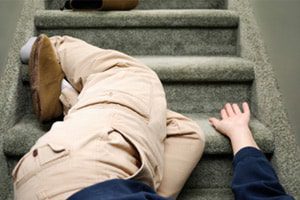
The number one cause of spinal cord injuries in the United States is not from car crashes, which had previously been the case, but falls in the elderly, a new study reveals. According to a study involving more than 43,000 adults, researchers found that in seniors—people 65 years of age and older—79 people per every […]
 The number one cause of spinal cord injuries in the United States is not from car crashes, which had previously been the case, but falls in the elderly, a new study reveals.
The number one cause of spinal cord injuries in the United States is not from car crashes, which had previously been the case, but falls in the elderly, a new study reveals.
According to a study involving more than 43,000 adults, researchers found that in seniors—people 65 years of age and older—79 people per every million suffered a spinal cord injury due to a fall in 2007. In 2009, that figure rose to nearly 88 per million, according to Johns Hopkins Medicine, wrote HealthDay News. The study appears in the January 23rd issue of the Journal of Neurotrauma.
“We are seeing a changing face in the epidemiology of spinal cord injury,” study co-leader Dr. Edward Hammond, a research associate at the International Center for Spinal Cord Injury at the Kennedy Krieger Institute in Baltimore, said in the news release, HealthDay News reported.
Falls accounted for 41.5 percent of the spinal cord injuries seen during the study period; vehicular crashes comprised 35.5 percent. Also, fall-related spinal cord injuries accounted for 30 percent of injuries seen in seniors in 2009, an increase from the 23.6 percent seen in 2007, according to HealthDay News. The study also revealed an increase in the average age of adults who suffered a spinal cord injury, from age 41 to 51 between 2000 and 2005, according to HealthDay News.
The study did not provide a specific reason for the increases; however, the aging of the American population is a potential factor. “We have demonstrated how costly traumatic spinal cord injury is and how lethal and disabling it can be among older people,” study co-leader Dr. Shalini Selvarajah, a post-doctoral surgical research fellow at the Johns Hopkins University School of Medicine, said. “It’s an area that is ripe for prevention,” he added. Seniors with spinal cord injuries have a four-fold increased likelihood of dying from these injuries in an emergency room and a six-fold increased likelihood of dying after admission to the hospital with a spine injury, HealthDay News reported.
With the senior population aging and living longer, people face increasing challenges regarding elder care for their loved ones, especially in the face of seemingly routine nursing home neglect and abuse reports. Meanwhile, use of antipsychotics, antidepressants, and sedatives in U.S. nursing homes has risen sharply, leading to significant issues with the unnecessary dosing of the elderly. Typically, these drugs are prescribed off-label and are being tied to falls, other accidents, and deaths in the elderly. No drugs are currently approved by the U.S. Food & Drug Administration (FDA) to manage agitation, aggression, and hallucinations in the elderly and those who are diagnosed with Alzheimer’s disease and dementia.
The FDA indicates that antipsychotics may lead to dizziness, sudden blood pressure drops, abnormal heart rhythm, blurred vision, and urinary problems in dementia patients. Despite this, reports reveal that more than one in five U.S. nursing homes has administered antipsychotics to people who have no diagnosis for a condition for which these drugs are approved. In 2010, about 185,000 U.S. nursing home residents received antipsychotics even though prescribing these drugs went against federal nursing home regulator recommendations. For example, many of these residents were suffering from Alzheimer’s disease or some other dementia-related disorder, even though antipsychotics are intended for people who are diagnosed with schizophrenia. The implications of these off-label prescribing practices are considerable: Some 5.2 million Americans are diagnosed with Alzheimer’s disease today; by 2025, that number could reach 7.1 million, according to the Alzheimer’s Association.
A 2001 Congressional report revealed that about one out of every three U.S. nursing homes were cited for at least one abuse violation during a two-year period. “In over 1,600 of these nursing homes, the abuse violations were serious enough to cause actual harm to residents or to place the residents in immediate jeopardy of death or serious injury,” the report stated.


